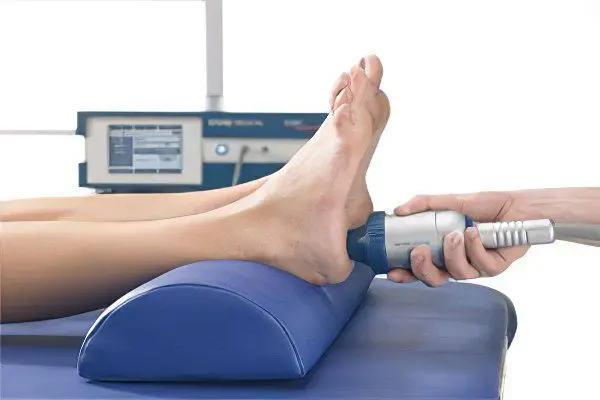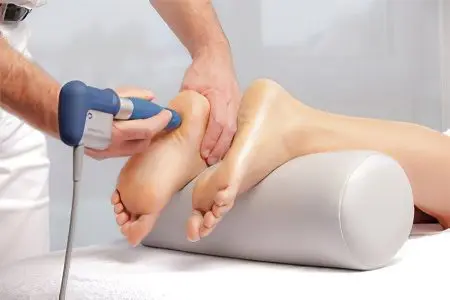Contents

Heel spur shock wave therapy is the treatment of a bone growth located on the heel bone on the plantar side using acoustic waves. A bone outgrowth can range in size from a few millimeters to 1,2 centimeters, it may not bother a person in any way, or it can provoke severe acute pain and lead to long-term disability.
Shock wave therapy is a physiotherapy method that avoids surgery when conservative treatment of heel spurs is ineffective. The technique was developed and first tested in Germany and Switzerland more than 20 years ago. Since then, it has established itself as one of the most effective methods for treating heel spurs and has become a complete replacement for surgery.
To complete the procedure, you will need specialized equipment, which is a source of shock sound vibrations.
The essence of the method of shock wave therapy for heel spurs
With the local impact of waves on the affected area, the existing seals and deposits are split. The shock wave blocks pain receptors, reducing sensitivity at the site of impact. Salt deposits are loosened, which helps to reduce the load on the fascia as the calcifications are washed out.
In addition, the process of tissue repair is accelerated, micro-ruptures of the fascia heal faster. Increased blood flow removes decayed salt deposits, and the nutrition of the heel bone is restored due to the normalization of metabolic processes.
Ultrasound has an effect at the molecular level, which allows not affecting healthy tissues and affecting only pathological areas. Intact heel tissues are protected from ultrasound by the existing elastic membrane. Pathological growths and deposits are destroyed due to the active mechanical and physico-chemical influence on them.
Impact of shock wave therapy on the body
Do not be afraid of treating a heel spur using the shock wave method. This procedure is widely used in medicine. For the treatment of various pathologies, waves of a certain length are used. For example, high-intensity waves are needed to destroy kidney stones. To get rid of a heel spur, medium and low-intensity exposure is enough. This allows you to reduce pain, relieve inflammation, gradually destroy existing deposits.
The specialist adjusts the frequency of pulses and the force of pressure manually, which makes it possible to select the optimal effect for each individual patient. The waves emanating from the apparatus act exclusively on the pathological focus, without exerting any influence either on adjacent tissues or on the body as a whole.
How is the procedure, advantages and disadvantages
Shock wave therapy for heel spurs cannot be started without prior preparation. To do this, the patient needs to consult an orthopedist, perform an X-ray examination or MRI, and also pass an analysis for blood clotting.
In addition, the doctor must examine the patient again, immediately before the procedure. Using the method of palpation, the doctor will determine the place on the heel that responds with maximum pain, and it is this area that will be exposed to waves. Most often, this is the center of the calcaneus.
The patient lies or sits on a couch, and a special gel is applied to the skin of the heel. Then the doctor installs a special sensor on the surface of the heel, which will be the source of shock waves. The specialist selects the angle of inclination of the sensor independently. Waves have the peculiarity of rapidly propagating through a liquid medium and reflecting from a dense tissue. Therefore, they pass through the soft tissues of the heel and affect the bone. Due to this, a therapeutic effect is produced.
During the procedure, the patient can feel only slight touches, the person will not see or hear the waves. The procedure is carried out either in a clinic or in a medical center, its duration varies from 10 to 30 minutes. At least 5 sessions are recommended for one course, it is possible to increase up to 7 procedures.
It is important that the interval between each visit to the physiotherapy room is at least 3 days, but not more than 20 days. During this time, tissues are restored, and decayed calcifications are excreted from the body. The doctor must inquire about the patient’s well-being, if the disease worsens, then the procedure is postponed.
The effect can be felt immediately after the first session, as the pain decreases immediately after the procedure by about 20%. The decrease in their intensity occurs for about 5 hours. They can disturb a person for several more days, either appearing or reappearing, but the degree of their severity will decrease all the time.
The results
So, thanks to the shock wave therapy of the heel spur, it will be possible to achieve the following results:
Reduce the intensity of pain;
Bring blood circulation back to normal;
Gradually dissolve and remove calcifications;
Strengthen the ligaments of the foot, the Achilles tendon.
Benefits of shock wave therapy for heel spurs

There are no side effects to this procedure. The patient will not experience allergic reactions, which is possible in the treatment of medications.
The effect of therapy will not be long in coming.
Treatment is carried out in an outpatient setting.
The patient has the opportunity to avoid surgery.
The procedure is comfortable for the patient, non-traumatic, does not cause pain or other irritations.
The procedure is short in time and does not take more than half an hour.
In addition to improving blood supply, relieving pain and inflammation, it will be possible to get rid of bone growth.
The therapeutic effect is achieved quickly and remains for a long time.
Disadvantages and contraindications of shock wave therapy for heel spurs
Shock wave therapy for heel spurs has no drawbacks – it is a quick and safe way to get rid of the existing pathology. The only disadvantage of the procedure can be considered the presence of contraindications that are available for any therapeutic effect on the body.
You can not conduct treatment sessions with the shock wave method in the following cases:
In the presence of oncological formations, including benign tumors.
During the period of gestation.
With violations in the work of the cardiovascular system: hypotension, arrhythmia, thrombophlebitis of the legs.
In infectious diseases in the acute phase.
With poisoning of the body.
Under the age of 18.
With diseases of the nervous system.
If there is bleeding in the foot area.
In violation of blood clotting.
Shock wave therapy is suitable even for those patients who have not been helped by conservative methods. It is possible to use this type of treatment both separately from other therapeutic effects, and in combination with physiotherapy and drug correction. The efficiency of UVT is at least 90%, and the result is characterized by persistent positive dynamics. However, the cause of a heel spur must be identified and treated. Only then can it be ensured that the spur does not form again.









